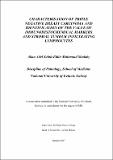| dc.contributor.advisor | Callagy, Grace | |
| dc.contributor.author | Shalaby, Aliaa Adel Salah-Eldin Mahmoud | |
| dc.date.accessioned | 2018-06-13T09:50:20Z | |
| dc.date.available | 2018-06-13T09:50:20Z | |
| dc.date.issued | 2017-10 | |
| dc.identifier.uri | http://hdl.handle.net/10379/7399 | |
| dc.description.abstract | Breast cancer is a complex disease that encompasses multiple molecular subtypes that have different clinical behavior. The behavior can be influenced by both the characteristics of the cancer cells as well as the surrounding microenvironment. Triple negative breast cancer (TNBC), is a breast cancer subgroup with important clinical implications, as its treatment remains problematic despite the recent advances in cancer therapy. The pathological, molecular and clinical diversity within this subgroup has hindered
standardization of a targeted therapy and prognostication of its outcome as an entire group. Therefore, the aim of this work is to review and characterize TNBCs diagnosed and managed in Galway University Hospital over a 15 year period with reference to outcome, clinicopathological features and candidate
markers with a view to identify any determinants of outcome.
A database of 355 TNBC patients managed at Galway University Hospital was constructed with detailed clinicopathological and outcome data. After a follow up of 42 months, 22% of patients experienced a recurrence of disease and 21% died from their disease. Only the traditional parameters of nodal status and tumour size were independent predictors of disease free, metastases free and breast cancer specific survival. In patients treated with neoadjuvant chemotherapy, a complete pathological response (pCR) was an independent predictor of outcome. Tumour type, tumour grade, age at diagnosis, breast cancer gene (BRCA) mutation status, basal status, androgen receptor status and other markers were not independent predictors of any outcome endpoint. Only B cell lymphoma-2 (Bcl-2) showed a potential independent prognostic role for metastases free and breast cancer specific survival; TNBC tumours with high expression of Bcl-2 were associated with longer survival rates on univariate and multivariate analysis, but not with nodal status or tumour size were included in the model.
A detailed evaluation of stromal tumour infiltrating lymphocytes (sTILs) was performed. sTILs was an independent predictor of disease free survival (DFS) and overall survival (OS) on univariate and multivariate analysis. The strongest association with outcome was observed when sTILs was tested in 10%
increments and was dichotomized with a cut-off of 25%.
The expression of two inflammation associated enzymes, cyclooxygenase-2 (COX-2) and inducible nitric oxide synthase (iNOS), was evaluated in a consecutive series of invasive breast cancers that included hormone receptor positive and negative tumours. Expression of COX-2 and iNOS was associated with well-differentiated tumours and with oestrogen and progesterone receptors positivity but not with outcome either in the entire series or in the hormone receptor positive or negative groups.
TNBC is a biologically diverse group of cancers with poor outcomes. Traditional parameters of nodal status, tumour size and pCR, where neoadjuvant chemotherapy (NACT) has been given, are independent determinants of outcome. This work highlights a potential independent prognostic role for sTILs in TNBCs. Further work is required to validate sTILs as a robust biomarker for prognostication of TNBC. | en_IE |
| dc.publisher | NUI Galway | |
| dc.rights | Attribution-NonCommercial-NoDerivs 3.0 Ireland | |
| dc.rights.uri | https://creativecommons.org/licenses/by-nc-nd/3.0/ie/ | |
| dc.subject | Triple negative breast cancer | en_IE |
| dc.subject | TNBC | en_IE |
| dc.subject | Tumour infiltrating lymphocytes | en_IE |
| dc.subject | sTILs | en_IE |
| dc.subject | Medicine | en_IE |
| dc.subject | Histopathology | en_IE |
| dc.title | Characterisation of triple negative breast carcinoma and identification of the value of immunohistochemical markers and stromal tumour infiltrating lymphocytes | en_IE |
| dc.type | Thesis | en |
| dc.local.note | This thesis examined the clinicopathological and immunohistochemical biomarkers which may perdict the prognosis of women with triple negative breast cancer. Tumour size, nodal status, the pathological response to neoadjuvant chemotherapy and the tumour infiltrating lymphocytes were important prognostic indicators of outcome. | en_IE |
| dc.local.final | Yes | en_IE |
| nui.item.downloads | 296 | |


